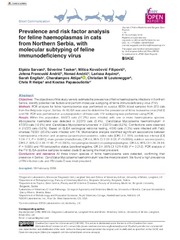Приказ основних података о документу
Prevalence and risk factor analysis for feline haemoplasmas in cats from Northern Serbia, with molecular subtyping of feline immunodeficiency virus
| dc.creator | Sarvani, Elpida | |
| dc.creator | Tasker, Séverine | |
| dc.creator | Kovačević-Filipović, Milica | |
| dc.creator | Francuski Andrić, Jelena | |
| dc.creator | Andrić, Nenad | |
| dc.creator | Aquino, Larissa | |
| dc.creator | English, Sarah | |
| dc.creator | Attipa, Charalampos | |
| dc.creator | Leutenegger, Christian M. | |
| dc.creator | Helps, Chris R. | |
| dc.creator | Papasouliotis, Kostas | |
| dc.date.accessioned | 2020-06-17T23:17:50Z | |
| dc.date.available | 2020-06-17T23:17:50Z | |
| dc.date.issued | 2018 | |
| dc.identifier.issn | 2055-1169 | |
| dc.identifier.uri | https://vet-erinar.vet.bg.ac.rs/handle/123456789/1837 | |
| dc.description.abstract | Objectives The objectives of this study were to estimate the prevalence of feline haemoplasma infections in Northern Serbia, identify potential risk factors and perform molecular subtyping of feline immunodeficiency virus (FIV). Methods PCR analysis for feline haemoplasmas was performed on surplus EDTA blood samples from 373 cats from the Belgrade region, Serbia. An ELISA was used to determine the prevalence of feline leukaemia virus (FeLV) and FIV; PCR was performed on a subpopulation of these cats. FIV subtyping was performed using PCR. Results Within this population, 64/373 cats (17.2%) were infected with one or more haemoplasma species. Mycoplasma haemofelis was detected in 20/373 cats (5.4%), ‘ Candidatus Mycoplasma haemominutum’ in 47/373 cats (12.6%) and ‘ Candidatus Mycoplasma turicensis’ in 23/373 cats (6.2%). Coinfections were observed in 21/373 cats (5.6%). Based on ELISA serological retroviral testing, 4/310 cats (1.3%) were infected with FeLV, whereas 78/331 (23.6%) were infected with FIV. Multivariable analysis identified significant associations between haemoplasma infection and anaemia (anaemic/non-anaemic, odds ratio [OR] 2.7, 95% confidence interval [CI] 1.04–7.1; P = 0.041]), male gender (male/female, OR 4.5, 95% CI 2.22–9.03; P <0.0005), outdoor access (yes/no, OR 5.2, 95% CI 2.28–11.92; P <0.0005), non-pedigree breed (non-pedigree/pedigree, OR 5.5, 95% CI 1.24–24.84; P = 0.025) and FIV seropositive status (positive/negative, OR 2.4, 95% CI 1.21–4.83; P = 0.012). PCR analysis of the FIV ELISA-positive samples revealed clade D as being the most prevalent. Conclusions and relevance All three known species of feline haemoplasma were detected, confirming their presence in Serbia; ‘ Candidatus Mycoplasma haemominutum’ was the most prevalent. We found a high prevalence of FIV-infected cats and FIV clade D was most prevalent. | en |
| dc.publisher | SAGE | |
| dc.relation | info:eu-repo/grantAgreement/MESTD/Basic Research (BR or ON)/175061/RS// | |
| dc.rights | openAccess | |
| dc.rights.uri | https://creativecommons.org/licenses/by-nc/4.0/ | |
| dc.source | Journal of Feline Medicine and Surgery Open Reports | |
| dc.title | Prevalence and risk factor analysis for feline haemoplasmas in cats from Northern Serbia, with molecular subtyping of feline immunodeficiency virus | en |
| dc.type | article | |
| dc.rights.license | BY-NC | |
| dcterms.abstract | Француски-Aндрић, Јелена; Сарвани, Елпида; Aндрић, Ненад; Ковачевић-Филиповић, Милица; Aqуино, Ларисса; Енглисх, Сарах; Таскер, Сéверине; Aттипа, Цхаралампос; Леутенеггер, Цхристиан М.; Хелпс, Цхрис Р.; Папасоулиотис, Костас; | |
| dc.citation.volume | 4 | |
| dc.identifier.doi | 10.1177/2055116918770037 | |
| dc.identifier.fulltext | https://vet-erinar.vet.bg.ac.rs/bitstream/id/4821/Prevalence_and_risk_pub_2018.pdf | |
| dc.type.version | publishedVersion |

